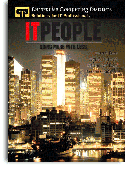IT Automation – Preface
First edition; 190 pages
ISBN: 0-13-013786-3
( by:Howie Lyke with Debra Cottone )
Introduction
As new and enhanced information technologies penetrate the enterprise at increasing rates, the IT executives who recommend and approve them are doing so with higher and higher expectations for increased automation and measurable returns.
In an automated enterprise, managers expect lower personnel requirements, greater reliability, quicker problem resolution, less downtime, and lower maintenance costs. With these benefits, no wonder the investment in new technologies continues to escalate. However, the complexities of distributed computing, integrated systems including outsourced service bureaus, and heterogeneous data centers have made these benefits difficult to come by. In many cases, the new data center environment is more manually intensive and more expensive to operate than ever before.
Lights Out, in its purest definition, is not a perfectly attainable goal. This book presents a methodology for achieving the highest level of automation possible.
This book addresses the problem with practical advice, guidelines and tools that will lead you through the analysis, planning, and implementation of data center automation projects. The process begins with an exercise that develops realistic expectations for a level of automation that you can expect to achieve in your data center environments.
Next, the book guides you through a gap analysis and the identification of automation requirements. Lights Out addresses IT organization and project staffing issues, followed by a thorough review of the steps, options, and considerations of the design phase. The particular challenges of planning an automation project are defined in the section on project planning.
Most IT managers will need to “sell” their automation initiative to upper management. This book details the steps and techniques required, including the development of financial plans and strategies. Of equal importance, you will find valuable, easy-to-apply tips and communications approaches to package and sell the total project.
This book also contains experience-proven guidelines for successful deployment and post-implementation improvement.
Data Center Definition
A data center is more than a computer room full of hardware and software. In the new enterprise, “the network is the data center.” The data center is comprised of the network and virtually everything attached to it-the computer center, workstations, desktops, and all related components.
Figure I-1 depicts a data center spanning two locations: a central area where the main computer room is located and a remote facility that is connected to the components in the computer room via a Wide Area Network (WAN). The central computer room contains enterprise (database), application, and file servers, communications equipment, and supporting hardware.
The distributed servers in the location where the computer room resides are located within and outside the computer room. In general, distributed servers may be located anywhere from a central computer room to the most remote locales of the enterprise, and at any point in between.
Data center production processes manage most if not all of the components shown in the Data Center Diagram. Take, for example, the distribution of software from the server to the desktop. Software distribution models, which consist of a combination of software and technical processes, centrally house and manage applications and make the software automatically available to other systems and to desktop users. The technical and administrative processes to effectively manage software distribution are executed by the data center.
As you read this book, remember that the term “data center” refers to the network, all of its components as illustrated above, and all of the technical and administrative processes that it executes.
Target Audience—Who Should Read This BookThe IT Executive
IT managers and executives, from director to CIO, will benefit from the content and layout of this book. Executive-level managers are responsible for providing direction, reviewing progress, and making key decisions regarding initiatives targeted at automating operations. To fulfill these management responsibilities, many rely solely upon their intuitive management skills and past experience. Lights Out serves as a reference guide and a useful resource to validate intuition and augment experience gained in different data center environments. In its pages, IT executives will find a thorough guide to decision-making, including key questions to ask in each phase of the project, from planning and budgeting through execution and fine-tuning. As a desk-side reference manual, Lights Out can be utilized to challenge assumptions, improve planning, and validate checkpoints and milestones being established as realistic and achievable.
The Operations Manager
Operations managers, tasked with managing front-line personnel and executing projects, will also use this book as a reference guide. However, the operations manager will reference this material from a different perspective. Whereas the IT executive provides direction, review, and approval, the operations manager develops the project, sets expectations and manages implementation to meet the executive’s focus on the IT mission, budget, and corporate objectives. To succeed, the manager must dive into the dirty details and follow each one of the disciplines described in this book. The manager should focus particularly on technical evaluation, planning, and associated cost management. The manager must then “sell” his/her proposal to the executive(s), without raising expectations beyond realistic delivery. And if that’s not enough, should he/she be successful in the sale-be careful what you ask for-the manager is then responsible to execute the plan and stick around to make it work!
Like the executive, the manager relies upon his/her intuitive management skills and past experience. All too often, one or more areas of discipline described in this book do not receive the appropriate level of attention, and the project is delayed, is underfunded, or proceeds without sufficient senior management support. Lights Out will take the guesswork out of planning, selling, and executing a successful data center automation initiative.
Infrastructure Personnel
Wherever they are located and whatever their position, all data center staff will benefit from reading Lights Out, by understanding how they can add value to an automation initiative and how they might be asked to participate. Any data center employee anticipating a pending automation project should use this book to prepare for the project. In addition, employees who think that their company should be investing in additional automation can use this book to initiate a project. In Lights Out, they will find the tips, tools, and a process to focus their manager on the right issues in the right way.
Consultants and Technology Vendors
Individuals who make a living in data center and infrastructure consulting or product and service sales will benefit from the practical advice, tips, and field-tested methodology described in Lights Out. They can use this material to validate previously used approaches and refresh their proposals. Since Lights Out is written from the perspective of the internal IT manager, the consultants and sales personnel will pick up valuable contextual sensitivity that should help them tailor communications to reflect real business issues. Lights Out deals with concerns that every thoughtful CIO and Infrastructure Services Manager will face as they consider additional automation and the investment in new technologies. In fact, Lights Out will help the consultant and salesperson to identify key questions that will or should be asked. As a result, proposals and on-going client interactions will be more relevant, effective, and productive.
The IT Management Students and Instructors
Students of information services and technologies will benefit from the practical, real-world reference materials, information, and examples contained in Lights Out. All students, full-time or part-time, about to begin an IT career or mid-career and climbing the management ladder, will gain access to the lessons learned automating data center operations in a myriad of organizations. By completing the exercises, students will develop valuable skills and understand the steps required to successfully scope, plan, and sell an automation initiative. By reading each chapter, students will expand their IT knowledge base. By discussing the materials in the classroom, students will validate their understanding versus the experiences and knowledge of their colleagues.
Instructors of IT can use Lights Out to teach the skills and processes that will be required in the real world of enterprise automation. The material lends itself particularly well to role playing, classroom discussion, and group assignments. Case studies may be developed, wherein the instructor supplies the case facts and the students use the materials to evaluate automation opportunities, scope and plan the project, develop the cost analysis, and role play the sales pitch.
Reader Assumptions
This book assumes that you understand general IT industry terms, have knowledge of or experience managing or working in a data center and supporting infrastructure, and understand the difference among mainframe, client/server, and distributed platform computing. In addition, I assume that you have basic project planning and project management experience and skills.
How to Read This Book
This book presents a methodology to plan and execute data center, infrastructure automation projects. In summary, the methodology takes you through the various phases of the project, and the chapters of the book are mapped to follow the methodology. In Chapters One and Two, the reader will define the purpose and scope of the automation project with a series of exercises that set realistic expectations, identify the problems and opportunities, and establish automation requirements. In Chapter Three, IT organization and project staffing issues and key considerations are highlighted. The details of design and a high-level project planning approach are presented in Chapter Four. The methodology suggests that the development of an effective financial strategy, described in Chapter Five, can be undertaken on a parallel track with design and project planning.
The next step involves packaging and selling the project to management. Chapter Six reviews the importance of communications throughout the project and offers a template for the final presentation prior to approval. Deployment, or a successful implementation, is described in Chapter Seven. Chapter Seven covers the post-implementation phase, which is referred to as continuous improvement.
To repeat, each chapter in this book maps to the methodology and to the symbols associated with each phase, as Table I-1 shows:
| Methodology Step-by-Step | Chapter Reference |
|---|---|
| Realistic Expectations | Chapter One: Lights Out Exposed |
| Chapter Two: Gap Analysis | |
| Chapter Three: The Organization | |
| Executable Design and Plan | Chapter Four: Design and Planning |
| Effective Financial Strategy | Chapter Five: Financial Planning |
| Project Approval/Management Support | Chapter Six: Communicating and Presenting the Plan |
| Successful Implementation | Chapter Seven: Deployment and Continuous Improvement |
| Continuous Improvement | Chapter Seven: Deployment and Continuous Improvement |
Each chapter begins with an introductory section containing the purpose of the chapter, orientation to the methodology, a narrative of a real situation that illustrates the application of the steps described in the chapter, and key questions that are addressed in the narrative.
The material is presented in several formats to allow for different learning styles. Each chapter contains some combination of narratives, tables, and figures that depict the processes.

















